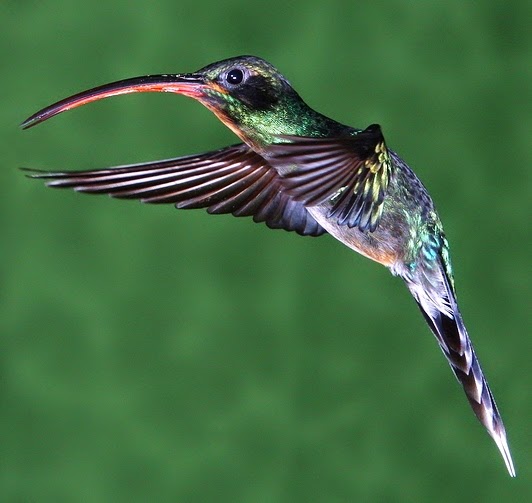 |
| Photo by Larry Thompson (Discover Life) |
Common name:
green hermit (en); rabo-branco-verde (pt); ermite vert (fr); ermitaño verde (es); grüner schattenkolibri (de)
Taxonomy:
Order Apodiformes
Family Trochilidae
Range:
This species is found from Costa Rica, through Panama and Colombia, and into Ecuador and Peru. Also in western Venezuela, and in north-eastern Venezuela and the island of Trinidad.
Size:
These birds are 11,5-15,5 cm long and weigh 4-6,5 g.
Habitat:
The green hermit is mostly found in the understorey of mountain forests, including forest edges, also using lowland rainforests and nearby second growths, moist scrublands and plantations. They are present at altitudes of 800-2.200 m.
Diet:
They feed primarily on the nectar of a wide range of pants, including Justicia umbrosa, Razisea, Pitcairnia, Costus, Drymonia, Heliconia, Malvaviscus palmanus, Columnea, Tillandsia fasciulata, Pachystachys and Centropogon. They also consume some small arthropods.
Breeding:
Green hermits breed in November-September, usually coinciding with the local flowering peak of the plants they obtain nectar from. They are polygynous, with males displaying in a lek to attract females and having no further part in the breeding process after mating. The female builds a cone-shaped nest made of soft plant fibres and vegetative down, and lined with seed-plumes. It is usually affixed to the underside of the tip of a free-hanging leaf by cobwebs, 0,5-4,5 m above the ground. There she lays 1-2 white eggs which she incubates alone for 17-18 days. The chicks fledge 21-23 days after hatching.
Conservation:
IUCN status – LC (Least Concern)
This species has a large breeding range and is described as uncommon to fairly common. Although the green hermit seems to persist even in fragmented habitats, any extensive deforestation caused by humans has the potential for harm.







